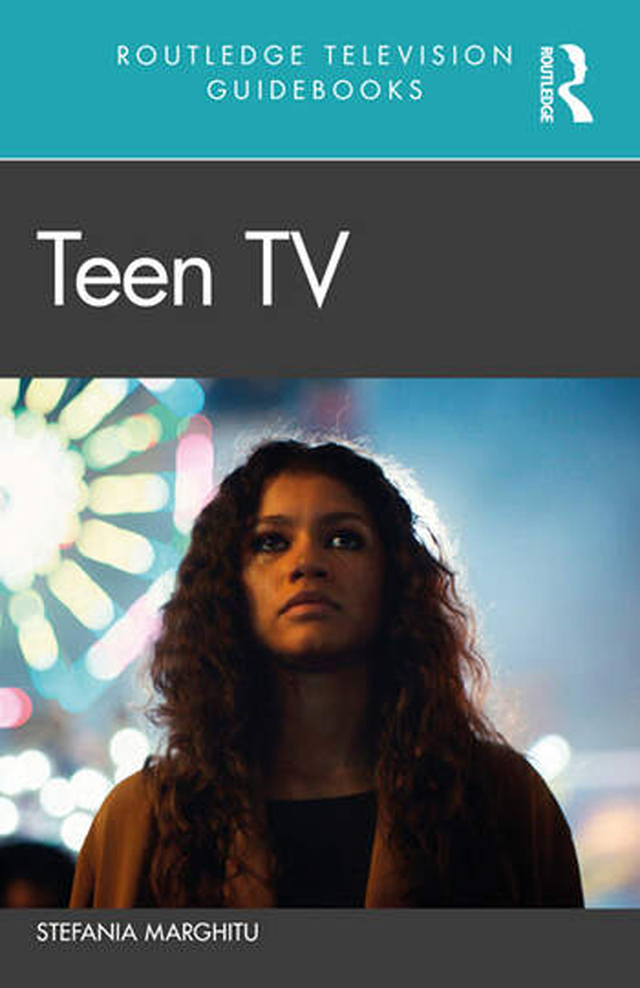The study of teens on screen is an expansive research field encompassing genre, identity, society, pop culture and beyond. Previous studies of teens on screen have tended to focus on teen films and the representation of teenagers within the American film industry, with few publications considering the equally rich history and portrayal of teenage culture on television. This is where Stefania Marghitu’s Teen TV (2021) steps in, filling this critical void with an updated history and reading of historical and contemporary global teen TV. Joining the growing Routledge Television Guidebooks series, this edition explores teen TV chronologically, presenting analysis of a wide range of historical and contemporary teen television shows, examining teens’ relationship with the changing medium of TV, the influences of pop and youth cultures on teen TV and the shifts in society which continue to inform the reflections of youth on screen.
Throughout the book’s four chapters Marghitu includes exclusive interview transcripts from a range of TV professionals who are, or have been, involved with teen TV shows. The interviews spread throughout this edition strengthen the extensive production studies material researched and discussed by Marghitu. Whilst all of the interviews featured in this edition raise engaging discussions surrounding teen TV, there are two which stand out for their refreshing discussions surrounding its evolution. The first can be found in Chapter Two, featuring an interview with producer and screenwriter Winnie Holzman. This interview provides insight into the writing of and for teenage audiences, with Holzman discussing how she balances drawing from her own experiences, visiting high schools and considering factors at play in broader society in order to deliver a balance between representation and authenticity of teenage culture in her hit show My So-Called Life (1994–1995: ABC). Another interview features in Chapter Three, distinctive in that it is an interview with a costume designer, Eric Daman, who is known for his work on the hit US series Gossip Girl (2007–2012: The CW/WB). Despite not being of showrunner status like the other interviewees, Daman’s discussion with Marghitu draws attention to factors beyond the writing and directing of teen TV, highlighting how fashion can be a key component in teen culture and played a pivotal role in Gossip Girl’s connection and appeal to teens. Daman also emphasizes how Gossip Girl endured and embraced the dawn of digital media and was one of the first teen TV shows to explore teens’ relationship with social media and changing technologies.
The first chapter brings a fresh perspective to the origins of teen TV, considering films’ influence on the genre and exploring how teens first emerged as stock characters before manifesting into their own genre in the early 1960s. Marghitu provides detailed contextualization of broader social justice and civil rights movements happening during the baby boomer generation, which influenced how teenage culture was reflected on both cinema and television screens. Additionally, this chapter provides discussion of Sally Field’s portrayal of a fifteen-year-old in ABC’s formative teen-focused show Gidget (1965–1966), which, over its one season runtime, would go on to help establish teen TV as a core genre in the sixties.
Chapter Two presents a new reading of Generation X teen TV, including a most interesting focus on Beverly Hills, 90210 (1990–2000: FOX). Here Marghitu’s textual and contextual analysis demonstrates how the glitzy teen drama contained progressive qualities for the time of its release and how during its expansive run time ‘became one of the first teen series to discuss issues of sex, drugs, and alcohol as pervasive rather than isolated cases’ (76–77). Moreover, this chapter provides extensive research on the rise of cable television and how the networks which it birthed ignited a new wave of teen TV.
Chapter Three moves onto millennial teen TV, here Marghitu considers the host of cultural, technological and ideological changes which influenced teen TV into the new millennium. Topics covered include the rise of social media, teen pregnancy, suicide and the broadening spectrum of gender and sexuality being explored in teen TV shows. Whilst this book primarily focuses on American teen TV, this chapter engages with examples beyond the US. Here, Marghitu presents individual case studies of British series Skins (2007–2013, E4) and Canadian series Degrassi: The Next Generation (2001–2015, CTV/Much Music/MTV Canada). Marghitu pairs these with further examples from Western culture in order to compare and explore global depictions of youth culture both on and off screen.
The central focus of Chapter Four is Gen Z teen TV. Marghitu recognises that, like each generation before Gen Z, youth engaged with and absorbed TV through an ever-changing technological format. This chapter, therefore, considers youths’ relationship with streaming platforms, the accessibility of the growing array of streaming networks and the diversifying range of teen TV shows to emerge from these networks. As with the previous chapters, Marghitu presents thorough socio-cultural and media industry analysis, supported by a case study and textual analysis of influential contemporary teen TV. For a study of Gen X teens, Marghitu looks to HBO’s Euphoria (2019–), which offers a rich array of narrative arcs and characters influenced by issues of gender identity, addiction and mental health, topics of immediate relevance for contemporary youth. This closing chapter illustrates the growing maturity of teen TV, with Marghitu illustrating how the genre continues to appeal to audiences beyond the teenage years.
Marghitu’s book offers a condensed yet comprehensive overview of teen TV, offering new scholarly digest on a broad scope of teen TV significant to the baby boomer, Generation X, millennial and Gen Z years. Marghitu eloquently demonstrates her breadth of knowledge in the field of critical and cultural studies of television, media industries, gender and sexuality studies and youth cultures. This book delivers a necessary, updated reading of teen TV, post #MeToo, #TimesUp, #BlackLivesMatter and LGBTQIA+ movements of recent and the rise of streaming networks. The blend of societal, industrial and theoretical study in Teen TV makes it an ideal book for scholars interested in television studies, youth and popular cultures and genre studies.
Competing Interests
The author has no competing interests to declare.

